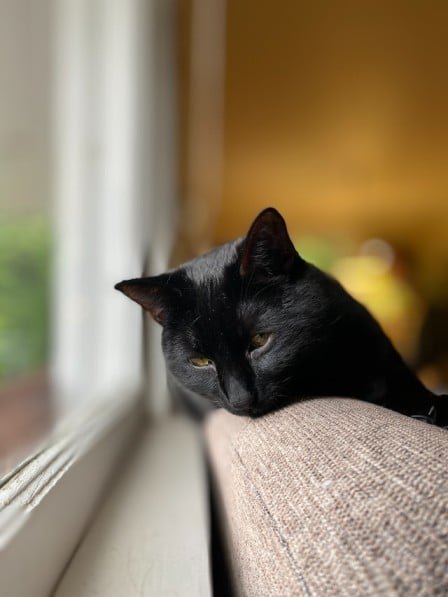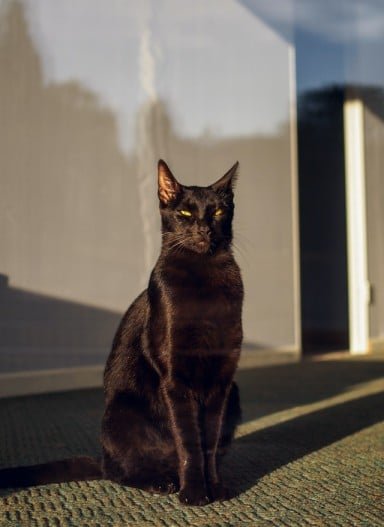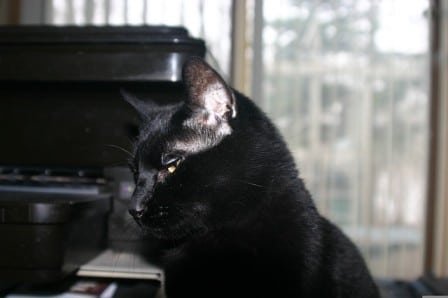Not many animals can compare or even come close to the elegance and sleekness of a black panther. It is extremely hard to mimic that majestic yet effortless essence of black panthers. However, it is not impossible.
What if I told you that there is a cat that has the same sublime black panther’s features, but you can cuddle and play with it? You would probably think I am crazy, but such a cat exists, and it is a Bombay cat!
Bombay Cat Characteristics
Appearance
| Fur color | Black |
| Fur pattern | Solid |
| Fur length | Short |
| Eye color & shape | Medium-sized and round copper, gold, or green eyes |
| Length | Males 15”-20” Females 12”-18” |
| Weight | Males 8-15 lbs Females 6-12 lbs |
| Expected lifespan | 15-20 years |
Personality
| Temperament | Highly social, craving for attention, active, curious, adaptable, and affectionate. |
| Kids and other pets | Kid-friendly cats that will enjoy playing with other pets too. |
| Sociable and cuddly | Extremely sociable cats that will act cuddly and playful even among strangers. |
| Activity level | Highly active cats that require a lot of attention and exercise. |
Requirements & Traits
| Feeding | High-quality meat-based food in wet and dry forms. Kittens and juveniles should eat 3-4 times a day, while adults should eat two times a day. Occasional snacks and treats are allowed. |
| Grooming | Their sleek fur requires no special upkeep, and it won’t get matted even if you forget to brush it for several days. Still, brushing once a week is recommended, as well as monthly nail trimming and ear cleaning. |
| Shedding | Relatively low to moderate. |
| Hypoallergenic | No, although they don’t shed a lot, Bombay cats still exude the protein responsible for allergic reactions. |
History and Origins

The history of Bombay cats begins in 1950. That’s when Nikki Horner came to an idea to create a new cat breed that would look like a Burmese cat but with slick black fur and copper eyes. Basically, a pocket-sized black panther.
She decided to breed a black American Shorthair male that had beautiful copper eyes with a Burmese female cat. After several failed attempts, Horner managed to create cats that had short black fur, copper eyes, and a compact, muscular body. She named this new breed after a port city in India.
In 1970, the Bombay cat was finally recognized as a new cat breed. It started becoming more popular, and today, even though still relatively uncommon, it is a highly valued cat breed.
Bombay Cat Personality
If you think you are in charge of the time you will dedicate to your Bombay cat, you are deeply wrong! If they feel you aren’t giving them enough time and attention, Bombay cats will demand it. They are quite vocal cats, and they will stop at nothing when they crave attention.
This characteristic makes the Bombay cat the perfect pet for families with children. In such families, they will get all the attention they require and more.
Apart from being a bit needy, Bombay cats are playful, intelligent, curious, loving, affectionate, friendly, gentle, and loyal. They can often be found on their owner’s laps or somewhere near.
The adult Bombay cats keep the same playful nature as they were kittens, and you will often see them play. However, as they age, Bombay cats can become more placid. Their temperament becomes more contained, and they don’t bother you for attention as they used to. You might even start to miss their clinginess!
As a cat breed that needs a lot of attention, Bombay cats shouldn’t be left alone, at least not for prolonged periods of time. Try to always have someone at home, or at least get one more cat or another pet.
Speaking of other pets, Bombay cats get along not only with other cats but also with friendly dogs. This is especially true if your Bombay cat was raised along with those animals. In that case, they will be friends for life!
Bombay Cat Appearance

A Bombay cat breed was created in an attempt to mimic the exotic and sophisticated appearance of the black panther. Obviously, this attempt was quite successful!
Fur
Bombay cats have black, glossy, short, and slick fur, although some specimens will have a slightly fluffier coat. The fur is solid black and without any markings.
Some Bombay kittens can be born with small white patches on their chests and bellies. These patches are inherited from their Burmese side. However, if they possess even the tiniest bit of white fur, such cats are no longer considered to be real Bombay cats.
Eyes
Bombay cats have medium-sized and rounded eyes. The most desirable eye color for Bombay cats is copper. However, some Bombay cats can have yellow, orange, gold, and even green eyes, especially if they are bred in Britain. In the US, a Bombay cat would be disqualified from shows or other competitions if it had green eyes.
Size
Bombay cats are medium-sized cats, and males are larger than females. Male Bombay cats weigh between 8 and 15 pounds, and their body length is somewhere between 15 and 20 inches. Female Bombay cats usually weigh between 6 and 12 pounds, and their body length is somewhere between 12 and 18 inches.
Other Body Characteristics
Bombay cat’s body is muscular, but it is neither compact nor rangy. The tail is straight and medium in length. The legs are proportionate with the body and tail. Paws are round, with five toes on the front and four toes on the back.
American Vs. British Bombay Cats
There are slight differences between American and British Bombay cats. American Bombay is a hybrid between Burmese and American Shorthair cats. British Bombay is a hybrid between Burmese and British Shorthair cats.
As a result, they aren’t completely the same, although they are similar enough to be considered the same breed. For instance, American Bombay cats have copper, yellow, orange, or gold eyes, while British Bombay cats can have green, yellow, or orange eyes.
American Bombay has a smooth coat and a medium-sized body. British Bombay has a fluffier coat and a slightly shorter muzzle than its American cousin. American Bombay cats are more athletic, while British ones are calmer and more intelligent.
The head is rounded, with wide-set eyes and ears. The muzzle and the nose are also rounded, which is in line with other Bombay cat features.
Daily Life With Bombay Cat
Bombay cats are great pets that aren’t too demanding. Still, there are some requirements to follow to ensure your cat is healthy and happy.
Feeding
Bombay cats are prone to obesity due to their American Shorthair ancestors. Also, their stocky build and black fur make it harder to notice when the cat puts on some excess weight. That’s why you need to be careful when feeding your Bombay cat.
It is not recommended to try free feeding with this cat breed. Free feeding is when you leave food out all the time so that the cat can eat whenever it wants. Instead, try to offer two, max three meals in one day if your Bombay cat is fully grown. For kittens and juvenile Bombay cats, eating 3-4 times a day is optimal.
Choose high-quality meat-based foods. Combine the dry and wet foods because both types of cat food have certain benefits. Your Bombay cat can also eat raw meat, but only if you keep it in the fridge for several hours. This way, you will prevent potential parasite contamination and/or food poisoning.
Grooming
Because of their slick and short fur, Bombay cats require little to no upkeep at all. Their fur won’t get matted even if you don’t brush it. However, regular brushing helps distribute the oils from the skin into the fur, which makes the skin clean and fur shiny.
Brush your Bombay cat once a week. These cats are extremely clean, so you won’t have to bathe them, except in some situations when they aren’t able to clean themselves. If that ever happens, wash your cat gently with lukewarm water.
Dental hygiene is also very important, but unless you train it from a young age, the Bombay cat will probably resist your attempts at teeth brushing. In that case, you can provide some treats or toys that are specifically made to clean the teeth while the cat chews on them.
Trim your Bombay cat’s nails once a month. If you can’t do it yourself, take it to the professional cat groomer. Clean the ears with a damp cloth or cotton pad. Don’t use cotton swabs because they increase the chance of injuries and ear damage. Use damp cotton pads to gently clean the eye area if needed.
Activity
Bombay cats are highly active cats that require exercise and attention. That’s why you should get them cat toys and scratching trees. You should also take some time every day and dedicate it to playing with your cat. With Bombay cats, it is simply not enough to just buy them toys and let them play alone.
You can play some usual games with your cat. You can let it chase you, or you can hide and let it find you. Playing fetch could also be fun, and you can also come up with your own games.
Bombay cats love to sit by the window, where they can observe the outside world. Make sure to provide them with such a place. Also, these cats can be let out to play outside. Some even live as outdoor cats.
However, it is recommended that you keep your Bombay cat indoors. You can let it play outside under your supervision. You can also train it to go for walks with a leash or harness.
If you want your cat to be even more active, you can get another cat or even a dog. Make sure to find an animal that will match the Bombay cat’s temperament. Bombay cats require companions that will be just as active, curious, and playful.
If you have children, then your problem regarding the activity levels of your Bombay cat is solved! Both children and Bombay cats are active, playful, and curious, and they will enjoy each other’s company.
Most Common Bombay Cat Health Issues

Although Bombay cats are generally healthy, they can still be affected by some common health issues. Some of these issues are relatively frequent among Bombay Cats due to their specific anatomy.
Hypertrophic Cardiomyopathy
Probably one of the most common feline diseases, hypertrophic cardiomyopathy is a condition in which the heart muscle walls become enlarged and thickened. This decreases the efficiency of the heart and can even affect other body parts.
In the most severe cases, hypertrophic cardiomyopathy can cause heart failure and death. The exact causes of this condition aren’t completely determined. However, some cat breeds are more prone to this disease, leading scientists to believe that genetics is the main factor contributing to hypertrophic cardiomyopathy.
Excessive Tearing Of The Eyes
Bombay cats are prone to excessive tearing of the eyes. This condition can be caused by conjunctivitis, allergies, corneal ulcers, eye injuries, eye infections, abnormal lashes, glaucoma, and various anatomical abnormalities.
While this condition is certainly less dangerous than some others, it can be annoying. If left untreated, it can cause a chronic tear staining of the fur. Also, it can be slightly irritating and prevent your cat from seeing clearly. However, if you take your cat to the vet and the vet finds the cause of the condition, it can easily be treated.
Don’t let the benign nature of this condition fool you. Although excessive tearing is not dangerous per se, it can be a sign of some other more serious condition that you don’t want to ignore.
Breathing Difficulties
Many animals that have short muzzles suffer from breathing difficulties because they have short breathing canals. Unfortunately, the Bombay cat is one such animal, as it has a really short muzzle.
Beware if you notice your cat frequently snoring while sleeping. There are some other symptoms, such as noisy breathing, panting, coughing, gagging, and evident difficulty swallowing and breathing. All these things could mean your cat is breathing with difficulty.
Make sure to take your cat to the vet as soon as possible. Imagine if you were in its place, and you had trouble breathing. You wouldn’t ignore it, would you?
Obesity
Another condition that’s becoming more common lately, obesity is a serious problem that sometimes goes undetected. Bombay cats need enough exercise to keep their healthy weight. When they live indoors with you, it can be hard to provide them with enough physical activity. It might be even harder to not give them treats.
Still, you need to be strict when it comes to feeding your Bombay cat. It has a rounded body and black fur, and it can sometimes be hard to notice that it gained weight. Obese cats are at higher risk of many diseases, including diabetes, joint pain, and various cardiovascular diseases.
Craniofacial Defect
Burmese cats are prone to developing a type of genetic mutation that affects the head and skull development. Since Bombay cats are direct descendants of Burmese cats, they can inherit this condition too.
However, since this condition is incompatible with life, kittens that have this mutation come out of their mother’s womb as stillborns. This means your Bombay cat doesn’t have this condition, but it can be a carrier for such genetic mutations.
If you spayed/neutered it, you don’t have to worry about it. However, if you plan to breed your Bombay cat that carries this mutation, the kittens might not survive, especially if the other parent has the same mutation.
Bombay Cat Name Suggestions
Enough talking about health issues; let’s move to a more pleasant subject – choosing a name for your Bombay cat! Since these cats are known as little black panthers, many people choose names that reflect that.
However, you don’t have to follow that unwritten rule. There are many other great names for Bombay cats, so let’s take a look at some of them!
- Phantom
- Shady
- Smokey
- Hocus Pocus
- Banzai
- Rai
- Aladar
- Cleo
- Ace
- Blackie
- Pepper
- Spooky
Buying or Adopting A Bombay Cat?
Although Bombay cats are not so common, you could easily find some in a shelter or buy them from a breeder. Another good news is that they aren’t as expensive as some other rare cat breeds.
If you decide to adopt a Bombay cat, you will have to pay $75-$150. If, however, you decide to buy it from a reputable breeder, it will cost you $500-$700. In some cases, Bombay cats can cost $2000, but those are usually top-quality and purebred specimens.
Bombay Cat Alternatives
Bombay cats are surely lovely, but if you fail to find one at an adoption shelter or a breeder, you might want to consider an alternative. Since Bombay cats are basically miniature black panthers, the closest alternative is a regular, domestic, shorthair black cat.
If, however, you want a purebred cat, you need to look further. Since Bombay cats are created by crossing black American Shorthairs and Burmese cats, both of these breeds are great Bombay alternatives. Some other cool alternatives are Havana Browns and Exotic Shorthairs.
Frequently Asked Questions
Having black fur is not enough. For a cat to be considered a true Bombay cat, it needs to have copper, orange, gold, or yellow eyes. It needs to have short and slick fur and resemble a black panther with its rounded features.
Bombay cats live between 15 and 20 years.
No, if a cat has white hair, even the smallest patch, it is not considered a purebred Bombay cat.
Yes, Bombay cats are extremely cuddly. Oftentimes, they will be the ones to initiate cuddling.
Although they can swim, Bombay cats will rarely do so unless absolutely necessary. They don’t like water very much, so don’t expect them to enjoy swimming and getting wet.
Bombay Cat Fun Facts
If you want to learn more about these cool cats, here are some fun facts:
- Bombay cats are bossy. Although they are sociable and friendly, they prefer to be the ones in control. They will often take control and boss other pets around.
- Bombay cats love to burrow. You will often find them hidden under the pile of clothes or under your bed covers. Make sure to always check such places before sitting or lying down. You don’t want to squish your cat!
- Bombay cats could win a staring contest. They can stare at you for prolonged periods of time, which can be a little creepy. However, there is no need to worry, this is completely normal behavior. They are probably just studying you because they like you.
Summary
When the first civilizations tried to domesticate cats, they probably chose specimens that were docile, placid, and the least threatening. Basically, they chose the cats with the least wild features.
Nowadays, we are going in the opposite direction. Cat breeders are looking for ways to create cat breeds that will look wild but still act as typical domesticated cats.
Bombay cats are one of the cat breeds that resulted from such efforts. Cat breeders breed Bombay cats to resemble black panthers and other wild cats. However, they are still great pets, perfect for your home.
If you want a cat that will look mysterious, wild, and elegant while being extremely cuddly and affectionate, then the Bombay cat should be your number one choice!
